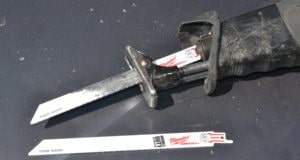This University of Extrication Newsletter sets out to give vehicle rescue instructors the ability to accurately answer an airbag question.
Knowing most driver’s airbag units have sodium azide chemical in their inflator unit, inevitably someone will ask “So which airbag locations can have stored gas inflators?” Good question. How would you answer?
What you are looking at above is the backside of a deployed drivers’ frontal airbag unit removed from a 2002 Dodge Stratus 4-door sedan. The back of the inflator unit immediately indicates that it is a dual stage design; note the two pair of inflator wires and yellow connectors. Driver airbag modules are typically the chemical inflator design. This ’02 Dodge unit is different however.
For this image above, we cut away the steering wheel and most all of the driver’s airbag exposing the front side of this same dual stage inflator module. You can see that the inflator has been scorched as it deployed this airbag. The large vent holes that allowed the gas to flow from the inflator into the airbag as it inflated are also visible.
Looking closely at the white label on the inflator shown by itself, we read that it is a TRW inflator manufactured in Mesa, AZ. Most importantly for our discussion, the label also states that it is a compressed gas unit meeting the criteria of UN3353 hazard classification. Have the HazMat guys in your class look up UN 3353. It covers compressed gas air bag inflators and compressed gas seatbelt pre-tensioners.
So there you have your answer to your student’s question. As an instructor, you can now say that you know that stored gas inflators can be found in ANY airbag location inside a vehicle including the driver’s frontal airbag!
 University of Extrication Ron Moore's University of Extrication is the online home for training tips, news and information pertaining to vehicle extrication and rescue.
University of Extrication Ron Moore's University of Extrication is the online home for training tips, news and information pertaining to vehicle extrication and rescue.






